Free shipping on USA orders over $129!
I recently did an article called Productive Afternoons, and in it I mentioned that in Charlotte Mason’s schools formal lessons were done by lunch. Well, we received many questions about how lessons could be done by lunch, so I want to do a couple of things in this article.
First, I want to show you some of Charlotte Mason’s time-tables, so you can see how she finished lessons before lunch. Then, I also want to give you some ideas and sample schedules that show how you could potentially finish lessons before lunch in your home school.
Now, I don’t want you to get hung up on these particular schedules that I’m going to show you. There is no one right schedule that fits all families perfectly. That’s one reason I’m only showing you three days of each schedule. I don’t want you to try to force your family to fit somebody else’s schedule; I want you to glean ideas from these schedules and use them to fine tune your own.
You need to find what works for your family, but there are three key principles to keep in mind as you set up a weekly and daily schedule.
Principle #1: Keep lesson times short and focused. You can accomplish a lot in a short amount of time if your child has the habits of full attention and best effort. Work toward those habits by keeping lessons short, especially in the younger grades. You’ll be able to see the ideal lesson lengths on Charlotte Mason’s schedules that I’ll show you in a just a minute.
Principle #2: Provide a wide variety of subjects. You don’t do every subject every day, but throughout the week you should spread a wide feast with many different subjects. Charlotte believed that children require a generous curriculum. So don’t get stuck in the 3 Rs.
Principle #3: Watch your sequence of subjects each day. Your children will find it easier to pay full attention and give their best effort if you alternate a more intense subject followed by a less intense subject in your schedule. Don’t do all your reading and narrating back-to-back; mix things up to use different parts of the brain in sequence. That varied order can make all the difference.
You will see those three principles on Charlotte’s time-tables. Keep them in mind.
When we look at a sample schedule for her classroom of about grades 1–3, we can see that those younger children started at 9:00 and went for two-and-a-half hours, finishing at 11:30. They had a half hour in the middle of that time to get up and move around with Swedish Drill, dancing, singing, and free play.
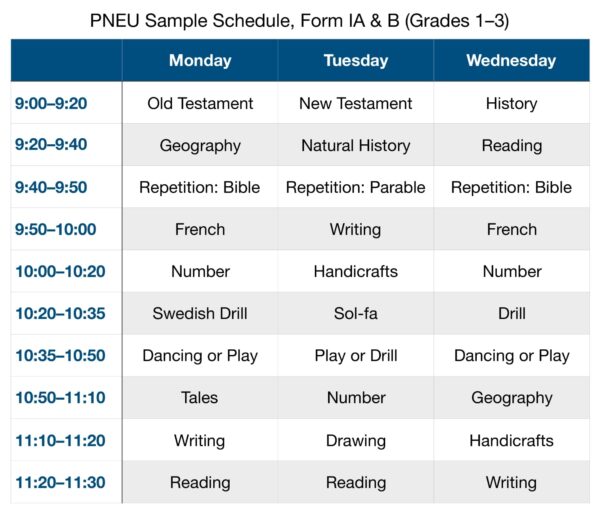

Grades (about) 4–6 went a half-hour longer, for three hours total, from 9:00 to 12:00 noon; and they too had a half-hour break in the middle for drill, singing, and play. But you can see the variety of subjects covered in just the three days that I’m showing, as well as the good sequencing of the subjects each day.
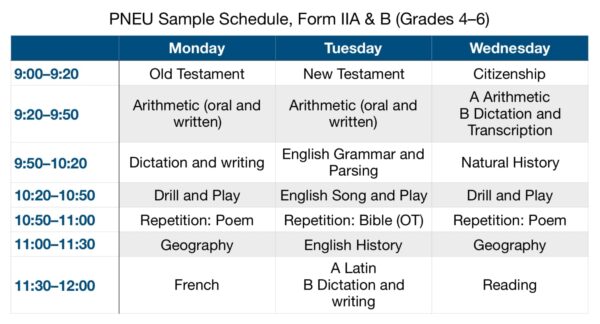

Grades 7 and 8 (approximately) worked a bit longer. Form IIIB (which would be about grade 7 for us) went from 9:00 to 12:15, and IIIA (or 8th grade) had one more class after that for an additional half-hour. So 7th graders worked for 3 hours and 15 minutes, and 8th graders for 3 hours and 45 minutes; but they both had that 30 minutes for drill, play, and song in the middle of the morning.
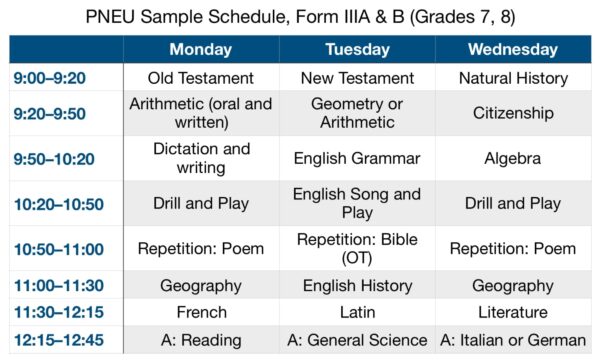

High schoolers went from 9:00 until about 1:00, but they also got that half hour partial break in their schedules.
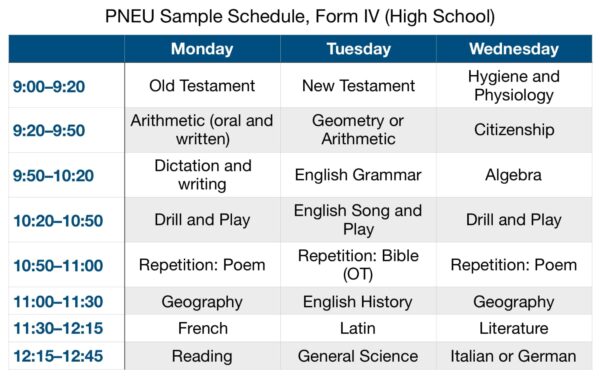

All of the grades used the afternoons for informal learning, such as music, catching up on their Book of Centuries or Book of Mottoes, doing nature study and nature notebooks, leisure reading, drawing, painting, handicrafts, and house work or garden work. All of those ideas are included on the free download we provided with the Productive Afternoons article.
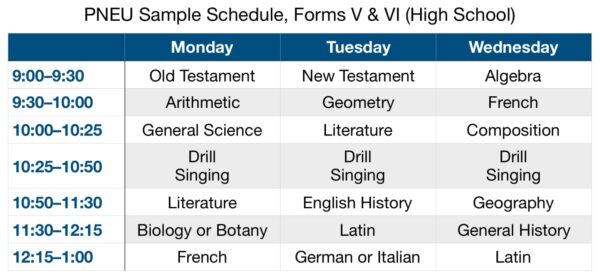

Now remember, I’m showing these samples to you simply to answer the questions about how Charlotte’s schools worked it out so that formal lessons were done before lunch. Your schedule does not have to look exactly like Charlotte’s did. Her time-tables were developed for grade-specific classrooms in England more than 100 years ago. That’s different from trying to figure out a schedule for multiple grade levels in a home school in 21st-century America (or Canada or wherever you happen to live).
Yes, many home schools also used Charlotte’s time-tables in her day, but they were mostly taught by a dedicated governess who wasn’t also trying to oversee meals and household chores and babies and preschoolers and laundry at the same time.
So let me encourage you: don’t become fixated on those samples and think that you have to follow them exactly or you’re not doing Charlotte Mason. Remember the principles and use them to create a schedule that fits your family and your situation.
I recently came across this statement in a pamphlet put out by Charlotte’s educational group, the PNEU. One section of their pamphlet was titled “Suggestions on How to Use the Programme.” Here is what they told parents and teachers:
“For length of periods see time-table. Even if, owing to children in different forms working in the same schoolroom, it is not possible to follow the time-table exactly, the suggested balance and variety should be maintained—a lesson in which much concentration is required should be followed by an easier one.”
So take from those schedules the appropriate lesson lengths, the example of a wide variety, and the principle of balancing heavy subjects with lighter ones throughout the day. Those are the important ideas.
With that in mind, let me give you some samples of what your schedule could look like to be finished with lessons by lunch. I have five samples, starting with only one student and gradually working up to five students spread clear through high school. Hopefully, you’ll be able to find a schedule that is close to your family’s situation and maybe glean some ideas from that sample.
First is a sample for one student in grade 2. Usually it’s not hard to be done with lessons by lunch when you have only one student. On this sample, you’re done almost an hour before lunch, so you have a lot of wiggle room to tweak and adjust as desired. If you wanted to move some of the afternoon occupations up into the morning hours, you could do that. Charlotte included drawing and painting and handicrafts in the morning hours for grades 1–3.
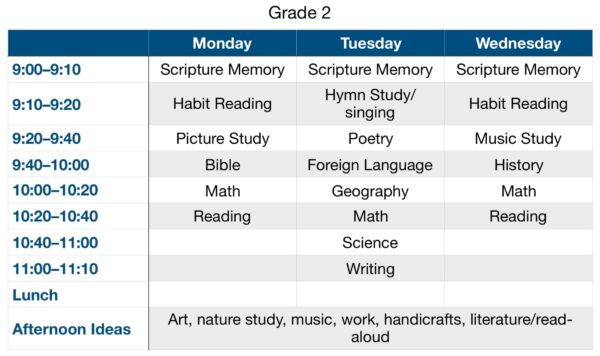

So finishing by lunchtime isn’t usually difficult with only one student. The trick is when you have multiple students.
Let me share the one idea that has saved my sanity and helped streamline my schedule more than anything else: combine your students for as many subjects as possible. Any subject that is topical, rather than skill-based, can be done all together as a family. So in the rest of the sample schedules, you will see the students combined for everything except math and language arts, and some of the upper level work. Let me show you.
Here is an example of a schedule for two students: one in second grade and one in fourth grade. It is divided into Family Work and Individual Work. The Family Work is done first on this sample. Once that is finished, we move to doing math and language arts individually. Then on Tuesdays we finish up with both students together for science. But you can see how the second grader is done sooner than the fourth grader, and both are done before lunch time.
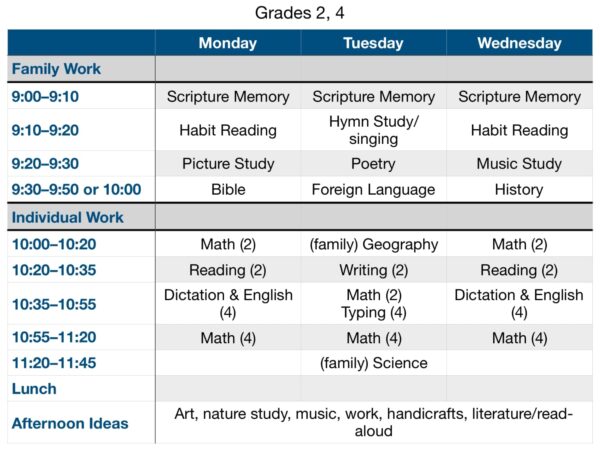

Let’s add one more student, a sixth grader. On this sample we’ve switched it and are doing Individual work first, then joining together to do Family work. You have freedom to arrange your schedule to best fit your family; do what works for you, keeping those main principles in mind. With three students in the mix, sometimes the older ones will be doing some of their work independently. The green text shows which student Mom is working with during those time slots. But even with three students, we’re still done by 12:15.
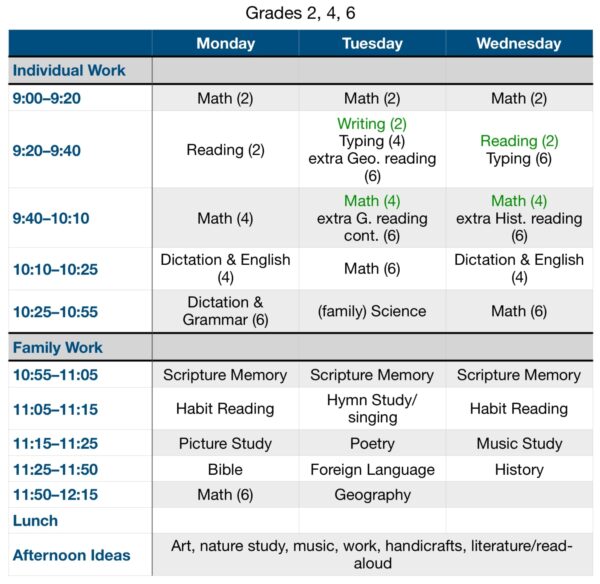

Let’s expand it still further. Here is a sample schedule for four students, ranging in age from second grade through eighth grade. In this sample, we’ve moved the start time up to 8:00, because those first two subjects each day can easily be done at the breakfast table. Then there is a 25-minute break for chores before lessons begin. Of course, you could switch those two and put chores first, then start lessons around 8:30. You’d still be done by noon, and your younger ones are done earlier, as they should be according to Charlotte’s time-tables; fewer hours for younger children.
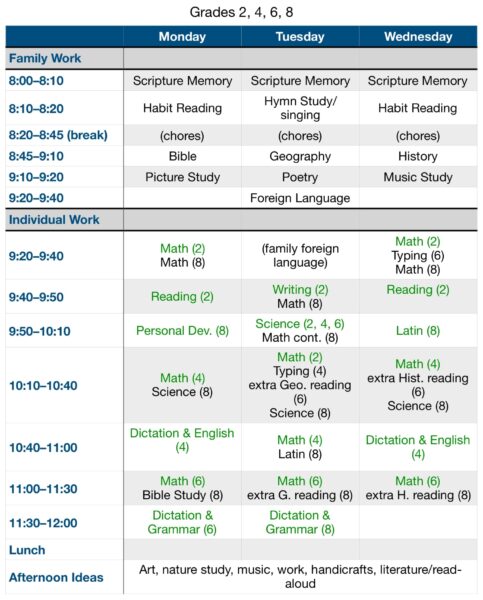

OK, last one. Here is an example of what a schedule might look like for five students, ranging from second grade through tenth grade. This one starts with the first two subjects at breakfast, then a break for chores, then the rest of the Family Work is done before breaking off into Individual work. The green text shows who Mom is working with and what independent work is happening during the time slots. At this point, the older students’ independent work is going to be more fluid than I was able to show on the time-table. Some of their assignments can overflow into the following time slots, but you get the idea. Even with five children, it is possible to be done with lessons before lunch time, working from 8:00 to 12:30.
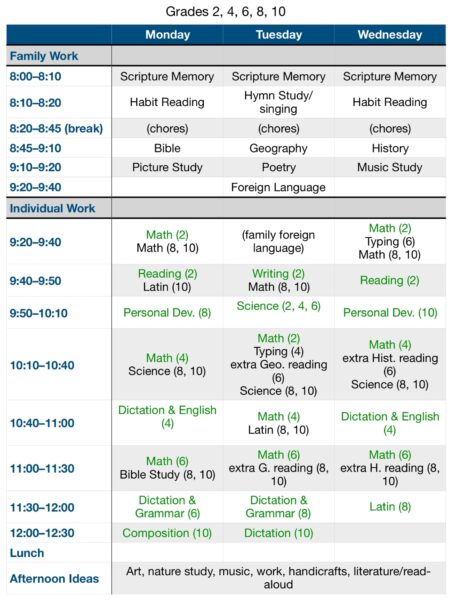

I hope these short samples have given you some ideas to create a schedule that will allow you to finish formal lessons by lunch time. We don’t have time right now to go into all the details about how to create a schedule, but let me point you to a resource that will take you by the hand and walk you through five steps to creating a customized schedule for your family. It’s called Planning Your Charlotte Mason Education.
Formal lessons done by lunch and productive afternoons. That’s a great combination!
Podcast: Play in new window | Download
Podcast (podcastv): Play in new window | Download

This encouragement arrived at precisely the right time. I shared your plans with my 8th & 6th grader this morning. They were delighted at the idea of fininishing by 12:30-1pm. We tweaked your ideas to suit our goals, and all 3 of us left the table hopeful and ready to give focused effort. What a great way to breathe new life into our school during the cabin fever days of winter.
Beth, we are excited for your family! It’s wonderful that both your 8th and 6th grader have been able to sit down and formulate ideas with you on how to suit your goals. Please keep us updated on how this works out for your family.
We are just getting started. Where we live, there isn’t much daylight in the afternoon and we wake up later in the winter. We need to do outside time in the morning. So technically if we followed your schedule we could fit it in, but we’d be eating breakfast more like 9 or 10. My kids are little, though. Anyway, just wondering about a sample schedule with 90 minutes in there for a walk.
Feel free to move things around on the sample, switch things up, take some things out, and add some things in to best fit your family during this season of life, Elizabeth. Those schedules are just a starting point. If you have little daylight outside during the afternoons, you might want to do a complete shift and have your walk and informal learning times in the morning and do all of your indoor school work in the afternoons. Depending on how “little” your kids are, you may not need formal school work at all. Charlotte Mason didn’t start formal lessons until the children were six years old. There is no “one right schedule.” Make one that will work for you.
So often I have wished for an opportunity to see how other homeschooling families make things work. I don’t have someone to sit in on and see, or to ask, “These are the goals of a Charlotte Mason education, but what do the logistics look like?” This post/video gives insight in the one area which my family struggles most in: scheduling. As the mother I maintain the heartbeat of expectation and keeping things going, and honestly, I struggle a lot even after months and years of training my children in the habits of attention and concentrated effort. They are still surprised and dragging feet that, yes, we have to do math yet again as we do every school day. Perhaps tweaking our schedule will help.
Great information. When the boys were younger, we used the CM method. Now that they are in high school, it is hard to know where to not go back to old textbooks. I am planning to look closer into the CM curriculum for next year. Are there any articles, videos, or books on homeschooling high schooler using CM method?
Thank you.
We have several articles in our Learning Library about using CM through high school. This series answers reader questions about CM for high school.
Do Thursday and Friday follow alternate Monday and Tuesday? Or are Thursday and Friday used for other activities?
Thursday and Friday would have a mixture of some subjects scheduled again and other different subjects too.
This is such a helpful article, as all are! I have learned so much and thank you for all your work. We are planning our year for grades 2,4,6. All three have piano practice and my grade 4 also has violin. They prefer instrument practice in the morning. When they are fresh, and it definitely works better! What would you suggest moving from the morning to the afternoon to make this flow nicely?
I would probably start by determining which subjects need them to be fresh; those would ideally stay in the morning time slots.
Another option would be to move many of the Family subjects (hymn singing, habit reading, picture study, music study, poetry, Scripture Memory) to after lunch; but be careful that moving those doesn’t leave you with read-and-narrate, read-and-narrate, read-and-narrate subjects back-to-back.
It does seem to make sense, however, that if you want the children to practice their instruments individually in the morning, you’ll have a hard time doing any Family work all together while that is going on (because somebody will always be missing). So perhaps it will work best for you to schedule Individual studies during the morning, including instrument practice, and then do Family studies after lunch.
You can always do a trial run: make a change to the schedule and run it for a couple of weeks. Then evaluate and adjust as needed moving forward.
Thank you Sonya! I had some similar ideas, which validates them, and you presented a couple other things I need to consider and remember.
I know they are just examples, but where could we get a view of the whole week schedule?
Thank you
There are so many ways to put together a whole week, Ivette. Each family’s schedule can look completely different. It’s a very personal decision based on what works best for your family during each season of life. We do have the whole week of subjects laid out for each of the components of a year of our curriculum. Those will give you the subjects that we recommend doing each day. Then you can determine (1) whether that weekly arrangement will work for you or if you want to tweak it, and (2) how you want to arrange the subjects each day to best fit your students during this season of life.
You can see a weekly sample schedule for history, geography, and Bible on each study’s page. So go to this history collection, choose a time period, and click on that book’s cover to see those sample schedules. Each one is different.
You’ll find a sample schedule for the other family subjects on this Enrichment Studies page.
Then add in the sample schedules for the Individual Studies in which you have students.You’ll find those book covers on this page.
You can compile your choices of those weekly subjects and customize for your family.
Hello, I am loving this resource and soaking up so much information. I am wondering what “habit reading” is, or if there is an article on it. Thanks so much.
Hi, Melissa. The term “habit reading” refers to once or twice a week reading to the children a lesson on your selected habit from Laying Down the Rails for Children. The two-volume set contains stories, Bible verses, poems, quotations, and family activities that relate to each of the 60 habits Charlotte Mason encouraged us to cultivate in our children. If you focus on one habit for two months, as recommended, the set gives you about ten years of character training material to use alongside the children’s practicing the habits.